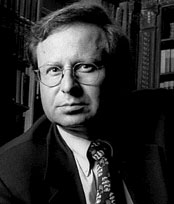A conversation with Steve Chu and Steve Koonin about the road to energy security.
 Steve Chu |
Editor’s Note: Steve Koonin is Chief Scientist of BP and Steve Chu is the Director of Lawrence Berkeley National Laboratory. The conversation was led by Francis Slakey, APS Associate Director of Public Affairs.
Q: As a result of the spike in gas prices over the summer, petroleum analysts claimed that the US is facing an energy crisis. Are they right?
KOONIN: The world is not running out of energy any time soon. There are plenty of fossil fuel resources in the ground, and there are other large-scale sources such as nuclear, hydro, electric, and wind. Particularly for oil and gas, though, there are concerns about access to resources because a lot of the countries that hold resources are not as politically stable as one would like.
CHU: There is plenty of carbon-based fuel available for at least 400 years. Eventually, there is going to be a plateau in the production of oil, probably about mid-century. But there is not a problem with the fossil fuel energy supply of unconventional oil and gas. We won’t run out of fossil fuel energy any time soon.
Q: Is energy independence a realistic goal? Or is energy security a more achievable goal?
KOONIN: “Energy independence” is the wrong phrase. The US is dependent on the rest of the world in many different ways and will remain so for the foreseeable future. The world is globalizing rapidly. “Energy security” is a much better phrase. This can be obtained, for example, by having a diversity of suppliers of a given type of energy, or by having the many different kinds of energy available to us. The fundamental problem is that most readily available and cheapest sources of energy are among the most polluting.
Q: Is the atmospheric concentration of CO2 at crisis levels or at warning levels? If it flattened out in the next 50 years, would it be manageable?
CHU: Climate change could have some very significant impacts, and these risks should be weighed in decisions. One doesn’t really have to say it is a certainty that these things will happen before you should be doing something. Just as we have health insurance, fire insurance, disaster insurance, we should be doing something to mitigate these risks. Once carbon is in the atmosphere, it circulates between the oceans and the land where the overall time it will take natural processes to recapture the carbon is hundreds of years. So the idea that you can wait and see what happens just to be very, very sure, given this long time constant, is not wise. You’ve got to do something now.
Q: The generation of electricity produces 40% of greenhouse gas emissions. Will sequestration technology lead to any significant reductions in emissions over the next few decades?
CHU: Carbon sequestration can make a very significant contribution, but sequestration is going to add cost to the generation of electricity. There is no technological addition that would make it cheaper than just venting CO2. One cost which is hard to estimate at present will have to do with the regulatory environment, and possible resistance to pumping thousands of atmospheres of CO2 underground –because there is a small chance it might leak. There are maybe a half a dozen small pilot projects going on now.
KOONIN: I believe that the technology can be developed to the point where it can reach the wholesale cost of electricity. It has yet to be demonstrated that the CO2 will stay down in the brine reservoirs for the required time, but we have good reasons to believe that it will. There are also above-ground technical issues. You need to be operating a power plant coupled to a chemical plant. They have very different time constants and operating characteristics. But the urgency is such that one has got to start on these things very soon because power plants last for 40 or 50 years.
Q: Some critics believe that pursuing sequestration technology locks the country into coal-fired power plants and prevents aggressive development of renewables. Can
 Steve Koonin |
KOONIN: It is not sequestration versus renewables; it’s sequestration and nuclear and renewables. The first two are the only technologies we know that can scale now to the magnitudes needed. Nuclear power is certainly a proven technology, and the incremental costs of the sequestration and nuclear are about the same. The fundamental problem is that all of these technologies cost more than just using the coal or the gas. While in the US and in Europe people will be willing to pay the incremental costs, half or more of the emissions in the next century will come from the developing world.
CHU: Both wind and solar, for example, are transient in nature. Photovoltaics need to achieve a factor of five or more lower cost before wide-scale deployment. The cost of wind-generated power is competitive with gas, but because it is a transient source, without efficient and cost effective energy storage, the base line will be nuclear power and coal in the near-term future. So you can put your pedal to the floor in sequestration and it’s not closing the door to renewable sources.
Q: What energy choices are being made in the developing world?
KOONIN: China is putting in 60 gigawatts a year of electrical generation capacity. That’s as much capacity as the UK has in total. Fifty of those 60 gigawatts are coal fired because that’s the fuel that is the cheapest. Who will pay the Chinese or the Indians not to emit? Businesses are not charities. So the government is going to have to step up to the plate.
CHU: China and India are looking at nuclear sources of energy, but it doesn’t come on instantly. You’re not going to build nuclear power plants as fast as you can build coal-based power plants because of the long construction periods, the regulatory issues, and so forth.
Q: Transportation generates 25% of greenhouse gas emissions. Do we need to be developing new fuels? What are the opportunities for improvements in fuel efficiency?
KOONIN: Efficiency is the first thing you do. There’s no reason that the US fuel economies couldn’t be improved by a factor of two if the political will was there. As for new fuels, it’s hard to beat liquid hydrocarbons for energy density, so they won’t disappear entirely from transport over the next 30 to 40 years. The real question is where you are going to get your liquid hydrocarbons. To make a megajoule of ethanol from corn takes about 0.3 megajoules of gas and 0.4 megajoules of coal, but only 0.05 megajoules of crude oil. So you’re multiplying the crude that goes in by a factor of 20. It doesn’t matter whether you lose energy in that process, because the liquid fuel is what you want. We generate electricity from coal and that throws away roughly 60% of the energy. But we still do it.
CHU: I agree. It’s really about the carbon balance. You might be throwing away factors of two and a half or more in total energy, but you’re converting something you’ve got a lot of to something you’re going to run out of, eventually. Biofuels, particularly going to cellulose-based fuels, is something that looks very fruitful, especially given the rapid development of the science and technology that can be brought to bear in this area. In the end, you want to transition from ethanol to a better fuel as quickly as you can. A lot of the research will be done on developing much less costly and energy-intensive ways of breaking down cellulose and turning it into a transportation fuel.
Q: What other technologies could help us transition to a carbon-reduced economy?
KOONIN: Building efficiency. Half of the world’s energy is used in buildings, so we need to learn how to use energy more efficiently in heating, ventilation, cooling, and lighting. Urban design is another important area. Right now, half of the world’s people live in big cities. By 2050, around 75% of the world’s people will live in big cities. How those cities are designed in terms of housing, transportation, and communications will greatly affect energy use.
CHU: We should also be paying a lot more attention to new technologies for long-distance electricity transmission. The most favorable technology would be very high voltage DC transmission: you have less current or discharge, so you have less radiation losses. DC is turning out to be cheaper once you go over 700 kilometers. It also makes the system much more robust because the synchronization to local AC lines is easier.
Q: If the US accepted a carbon cap and trade system, what amount would carbon have to be trading at to stimulate change?
CHU: It’s not as simple as that. What you really want in order to stimulate long-term investments is the assurance that there will be a bottom to the price of carbon trading. This is what Europe did in the development of wind technology. They said, “If the price of fossil fuels goes down below a certain amount, we will step in and make sure you’re not wiped out.” It was not seen as a huge subsidy, but a level of protection against volatility. If you adopt a carbon cap and trade system, you also need to be sensitive to the fact that it can’t be totally free market. With a stabilizing and reasonable floor, we would see a degree of long-term investments in R&D that could far exceed government investments.
KOONIN: If large companies are going to commit to developing and deploying low-emission or zero-emission energy sources, there must be some reasonable expectation of the economic environment–what the price of carbon will be on a 20-year time scale. At about $40 a ton of CO2, capture and storage and nuclear become quite competitive with the emitting sources. You will get carbon out of the power sector starting at $40 a ton. If you want to get carbon out of the transport sector, you probably can’t do it by economics because it’s about a factor of four or five more expensive per ton to save it in transport than it is to save it in power. So you’re going to have to get it out of transport by regulation.
CHU: A cap and trade system would stimulate further investments in developing far less carbon-emitting methods of producing bio-fuels.
Q: Does the US R&D enterprise need to be refocused in some way in order to transition to a carbon-reduced economy?
CHU: Yes. The good news is that a lot of scientists who were focused on very basic research are now waking up and saying, “Maybe I should start thinking about this problem.” Solving the energy problem is of such importance that it needs our best and brightest.
KOONIN: I think we are beginning to engage the world’s best scientific talent in these problems. But it also requires a research program that is rationally based, that certainly has a blue-sky component but also focuses on those technologies that look most promising. The program management needs to be much more technically informed. It needs to be sustained. And it needs to be able to fail.
CHU: …and we need to fail quickly. That’s the key to success. After some initial research tells you that a potential solution won’t scale properly, it is important to move on as quickly as possible to other opportunities.
©1995 - 2024, AMERICAN PHYSICAL SOCIETY
APS encourages the redistribution of the materials included in this newspaper provided that attribution to the source is noted and the materials are not truncated or changed.
Contributing Editor: Jennifer Ouellette
Staff Writer: Ernie Tretkoff
December 2006 (Volume 15, Number 11)
Articles in this Issue

